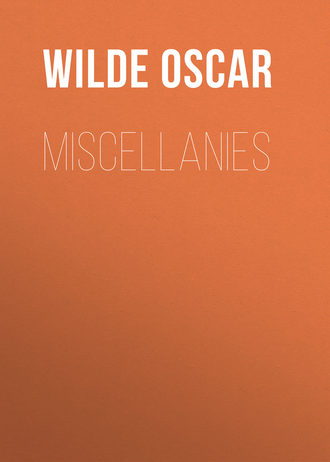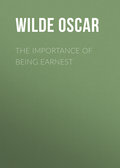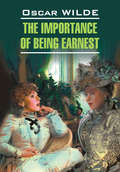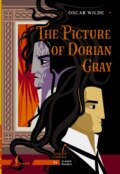
Оскар Уайльд
Miscellanies
Indeed, though the English poetesses up to the time of Mrs. Browning cannot be said to have produced any work of absolute genius, they are certainly interesting figures, fascinating subjects for study. Amongst them we find Lady Mary Wortley Montague, who had all the caprice of Cleopatra, and whose letters are delightful reading; Mrs. Centlivre, who wrote one brilliant comedy; Lady Anne Barnard, whose Auld Robin Gray was described by Sir Walter Scott as ‘worth all the dialogues Corydon and Phillis have together spoken from the days of Theocritus downwards,’ and is certainly a very beautiful and touching poem; Esther Vanhomrigh and Hester Johnson, the Vanessa and the Stella of Dean Swift’s life; Mrs. Thrale, the friend of the great lexicographer; the worthy Mrs. Barbauld; the excellent Mrs. Hannah More; the industrious Joanna Baillie; the admirable Mrs. Chapone, whose Ode to Solitude always fills me with the wildest passion for society, and who will at least be remembered as the patroness of the establishment at which Becky Sharp was educated; Miss Anna Seward, who was called ‘The Swan of Lichfield’; poor L. E. L., whom Disraeli described in one of his clever letters to his sister as ‘the personification of Brompton – pink satin dress, white satin shoes, red cheeks, snub nose, and her hair à la Sappho’; Mrs. Ratcliffe, who introduced the romantic novel, and has consequently much to answer for; the beautiful Duchess of Devonshire, of whom Gibbon said that she was ‘made for something better than a Duchess’; the two wonderful sisters, Lady Dufferin and Mrs. Norton; Mrs. Tighe, whose Psyche Keats read with pleasure; Constantia Grierson, a marvellous blue-stocking in her time; Mrs. Hemans; pretty, charming ‘Perdita,’ who flirted alternately with poetry and the Prince Regent, played divinely in the Winter’s Tale, was brutally attacked by Gifford, and has left us a pathetic little poem on the Snowdrop; and Emily Brontë, whose poems are instinct with tragic power, and seem often on the verge of being great.
Old fashions in literature are not so pleasant as old fashions in dress. I like the costume of the age of powder better than the poetry of the age of Pope. But if one adopts the historical standpoint – and this is, indeed, the only standpoint from which we can ever form a fair estimate of work that is not absolutely of the highest order – we cannot fail to see that many of the English poetesses who preceded Mrs. Browning were women of no ordinary talent, and that if the majority of them looked upon poetry simply as a department of belles lettres, so in most cases did their contemporaries. Since Mrs. Browning’s day our woods have become full of singing birds, and if I venture to ask them to apply themselves more to prose and less to song, it is not that I like poetical prose, but that I love the prose of poets.
LONDON MODELS
(English Illustrated Magazine, January 1889.)
Professional models are a purely modern invention. To the Greeks, for instance, they were quite unknown. Mr. Mahaffy, it is true, tells us that Pericles used to present peacocks to the great ladies of Athenian society in order to induce them to sit to his friend Phidias, and we know that Polygnotus introduced into his picture of the Trojan women the face of Elpinice, the celebrated sister of the great Conservative leader of the day, but these grandes dames clearly do not come under our category. As for the old masters, they undoubtedly made constant studies from their pupils and apprentices, and even their religious pictures are full of the portraits of their friends and relations, but they do not seem to have had the inestimable advantage of the existence of a class of people whose sole profession is to pose. In fact the model, in our sense of the word, is the direct creation of Academic Schools.
Every country now has its own models, except America. In New York, and even in Boston, a good model is so great a rarity that most of the artists are reduced to painting Niagara and millionaires. In Europe, however, it is different. Here we have plenty of models, and of every nationality. The Italian models are the best. The natural grace of their attitudes, as well as the wonderful picturesqueness of their colouring, makes them facile – often too facile – subjects for the painter’s brush. The French models, though not so beautiful as the Italian, possess a quickness of intellectual sympathy, a capacity, in fact, of understanding the artist, which is quite remarkable. They have also a great command over the varieties of facial expression, are peculiarly dramatic, and can chatter the argot of the atelier as cleverly as the critic of the Gil Bias. The English models form a class entirely by themselves. They are not so picturesque as the Italian, nor so clever as the French, and they have absolutely no tradition, so to speak, of their order. Now and then some old veteran knocks at a studio door, and proposes to sit as Ajax defying the lightning, or as King Lear upon the blasted heath. One of them some time ago called on a popular painter who, happening at the moment to require his services, engaged him, and told him to begin by kneeling down in the attitude of prayer. ‘Shall I be Biblical or Shakespearean, sir?’ asked the veteran. ‘Well – Shakespearean,’ answered the artist, wondering by what subtle nuance of expression the model would convey the difference. ‘All right, sir,’ said the professor of posing, and he solemnly knelt down and began to wink with his left eye! This class, however, is dying out. As a rule the model, nowadays, is a pretty girl, from about twelve to twenty-five years of age, who knows nothing about art, cares less, and is merely anxious to earn seven or eight shillings a day without much trouble. English models rarely look at a picture, and never venture on any æsthetic theories. In fact, they realise very completely Mr. Whistler’s idea of the function of an art critic, for they pass no criticisms at all. They accept all schools of art with the grand catholicity of the auctioneer, and sit to a fantastic young impressionist as readily as to a learned and laborious academician. They are neither for the Whistlerites nor against them; the quarrel between the school of facts and the school of effects touches them not; idealistic and naturalistic are words that convey no meaning to their ears; they merely desire that the studio shall be warm, and the lunch hot, for all charming artists give their models lunch.
As to what they are asked to do they are equally indifferent. On Monday they will don the rags of a beggar-girl for Mr. Pumper, whose pathetic pictures of modern life draw such tears from the public, and on Tuesday they will pose in a peplum for Mr. Phœbus, who thinks that all really artistic subjects are necessarily B.C. They career gaily through all centuries and through all costumes, and, like actors, are interesting only when they are not themselves. They are extremely good-natured, and very accommodating. ‘What do you sit for?’ said a young artist to a model who had sent him in her card (all models, by the way, have cards and a small black bag). ‘Oh, for anything you like, sir,’ said the girl, ‘landscape if necessary!’
Intellectually, it must be acknowledged, they are Philistines, but physically they are perfect – at least some are. Though none of them can talk Greek, many can look Greek, which to a nineteenth-century painter is naturally of great importance. If they are allowed, they chatter a great deal, but they never say anything. Their observations are the only banalités heard in Bohemia. However, though they cannot appreciate the artist as artist, they are quite ready to appreciate the artist as a man. They are very sensitive to kindness, respect and generosity. A beautiful model who had sat for two years to one of our most distinguished English painters, got engaged to a street vendor of penny ices. On her marriage the painter sent her a pretty wedding present, and received in return a nice letter of thanks with the following remarkable postscript: ‘Never eat the green ices!’
When they are tired a wise artist gives them a rest. Then they sit in a chair and read penny dreadfuls, till they are roused from the tragedy of literature to take their place again in the tragedy of art. A few of them smoke cigarettes. This, however, is regarded by the other models as showing a want of seriousness, and is not generally approved of. They are engaged by the day and by the half-day. The tariff is a shilling an hour, to which great artists usually add an omnibus fare. The two best things about them are their extraordinary prettiness, and their extreme respectability. As a class they are very well behaved, particularly those who sit for the figure, a fact which is curious or natural according to the view one takes of human nature. They usually marry well, and sometimes they marry the artist. For an artist to marry his model is as fatal as for a gourmet to marry his cook: the one gets no sittings, and the other gets no dinners.
On the whole the English female models are very naïve, very natural, and very good-humoured. The virtues which the artist values most in them are prettiness and punctuality. Every sensible model consequently keeps a diary of her engagements, and dresses neatly. The bad season is, of course, the summer, when the artists are out of town. However, of late years some artists have engaged their models to follow them, and the wife of one of our most charming painters has often had three or four models under her charge in the country, so that the work of her husband and his friends should not be interrupted. In France the models migrate en masse to the little seaport villages or forest hamlets where the painters congregate. The English models, however, wait patiently in London, as a rule, till the artists come back. Nearly all of them live with their parents, and help to support the house. They have every qualification for being immortalised in art except that of beautiful hands. The hands of the English model are nearly always coarse and red.
As for the male models, there is the veteran whom we have mentioned above. He has all the traditions of the grand style, and is rapidly disappearing with the school he represents. An old man who talks about Fuseli is, of course, unendurable, and, besides, patriarchs have ceased to be fashionable subjects. Then there is the true Academy model. He is usually a man of thirty, rarely good-looking, but a perfect miracle of muscles. In fact he is the apotheosis of anatomy, and is so conscious of his own splendour that he tells you of his tibia and his thorax, as if no one else had anything of the kind. Then come the Oriental models. The supply of these is limited, but there are always about a dozen in London. They are very much sought after as they can remain immobile for hours, and generally possess lovely costumes. However, they have a very poor opinion of English art, which they regard as something between a vulgar personality and a commonplace photograph. Next we have the Italian youth who has come over specially to be a model, or takes to it when his organ is out of repair. He is often quite charming with his large melancholy eyes, his crisp hair, and his slim brown figure. It is true he eats garlic, but then he can stand like a faun and couch like a leopard, so he is forgiven. He is always full of pretty compliments, and has been known to have kind words of encouragement for even our greatest artists. As for the English lad of the same age, he never sits at all. Apparently he does not regard the career of a model as a serious profession. In any case he is rarely, if ever, to be got hold of. English boys, too, are difficult to find. Sometimes an ex-model who has a son will curl his hair, and wash his face, and bring him the round of the studios, all soap and shininess. The young school don’t like him, but the older school do, and when he appears on the walls of the Royal Academy he is called The Infant Samuel. Occasionally also an artist catches a couple of gamins in the gutter and asks them to come to his studio. The first time they always appear, but after that they don’t keep their appointments. They dislike sitting still, and have a strong and perhaps natural objection to looking pathetic. Besides, they are always under the impression that the artist is laughing at them. It is a sad fact, but there is no doubt that the poor are completely unconscious of their own picturesqueness. Those of them who can be induced to sit do so with the idea that the artist is merely a benevolent philanthropist who has chosen an eccentric method of distributing alms to the undeserving. Perhaps the School Board will teach the London gamin his own artistic value, and then they will be better models than they are now. One remarkable privilege belongs to the Academy model, that of extorting a sovereign from any newly elected Associate or R.A. They wait at Burlington House till the announcement is made, and then race to the hapless artist’s house. The one who arrives first receives the money. They have of late been much troubled at the long distances they have had to run, and they look with disfavour on the election of artists who live at Hampstead or at Bedford Park, for it is considered a point of honour not to employ the underground railway, omnibuses, or any artificial means of locomotion. The race is to the swift.
Besides the professional posers of the studio there are posers of the Row, the posers at afternoon teas, the posers in politics and the circus posers. All four classes are delightful, but only the last class is ever really decorative. Acrobats and gymnasts can give the young painter infinite suggestions, for they bring into their art an element of swiftness of motion and of constant change that the studio model necessary lacks. What is interesting in these ‘slaves of the ring’ is that with them Beauty is an unconscious result not a conscious aim, the result in fact of the mathematical calculation of curves and distances, of absolute precision of eye, of the scientific knowledge of the equilibrium of forces, and of perfect physical training. A good acrobat is always graceful, though grace is never his object; he is graceful because he does what he has to do in the best way in which it can be done – graceful because he is natural. If an ancient Greek were to come to life now, which considering the probable severity of his criticisms would be rather trying to our conceit, he would be found far oftener at the circus than at the theatre. A good circus is an oasis of Hellenism in a world that reads too much to be wise, and thinks too much to be beautiful. If it were not for the running-ground at Eton, the towing-path at Oxford, the Thames swimming-baths, and the yearly circuses, humanity would forget the plastic perfection of its own form, and degenerate into a race of short-sighted professors and spectacled précieuses. Not that the circus proprietors are, as a rule, conscious of their high mission. Do they not bore us with the haute école, and weary us with Shakespearean clowns? – Still, at least, they give us acrobats, and the acrobat is an artist. The mere fact that he never speaks to the audience shows how well he appreciates the great truth that the aim of art is not to reveal personality but to please. The clown may be blatant, but the acrobat is always beautiful. He is an interesting combination of the spirit of Greek sculpture with the spangles of the modern costumier. He has even had his niche in the novels of our age, and if Manette Salomon be the unmasking of the model, Les Frères Zemganno is the apotheosis of the acrobat.
As regards the influence of the ordinary model on our English school of painting, it cannot be said that it is altogether good. It is, of course, an advantage for the young artist sitting in his studio to be able to isolate ‘a little corner of life,’ as the French say, from disturbing surroundings, and to study it under certain effects of light and shade. But this very isolation leads often to mere mannerism in the painter, and robs him of that broad acceptance of the general facts of life which is the very essence of art. Model-painting, in a word, while it may be the condition of art, is not by any means its aim. It is simply practice, not perfection. Its use trains the eye and the hand of the painter, its abuse produces in his work an effect of mere posing and prettiness. It is the secret of much of the artificiality of modern art, this constant posing of pretty people, and when art becomes artificial it becomes monotonous. Outside the little world of the studio, with its draperies and its bric-à-brac, lies the world of life with its infinite, its Shakespearean variety. We must, however, distinguish between the two kinds of models, those who sit for the figure and those who sit for the costume. The study of the first is always excellent, but the costume-model is becoming rather wearisome in modern pictures. It is really of very little use to dress up a London girl in Greek draperies and to paint her as a goddess. The robe may be the robe of Athens, but the face is usually the face of Brompton. Now and then, it is true, one comes across a model whose face is an exquisite anachronism, and who looks lovely and natural in the dress of any century but her own. This, however, is rather rare. As a rule models are absolutely de notre siècle, and should be painted as such. Unfortunately they are not, and, as a consequence, we are shown every year a series of scenes from fancy dress balls which are called historical pictures, but are little more than mediocre representations of modern people masquerading. In France they are wiser. The French painter uses the model simply for study; for the finished picture he goes direct to life.
However, we must not blame the sitters for the shortcomings of the artists. The English models are a well-behaved and hard-working class, and if they are more interested in artists than in art, a large section of the public is in the same condition, and most of our modern exhibitions seem to justify its choice.
LETTER TO JOAQUIN MILLER
Written to Mr. Joaquin Miller in reply to a letter, dated February 9, 1882, in reference to the behaviour of a section of the audience at Wilde’s lecture on the English Renaissance at the Grand Opera House, Rochester, New York State, on February 7. It was first published in a volume called Decorative Art in America, containing unauthorised reprints of certain reviews and letters contributed by Wilde to English newspapers. (New York: Brentano’s, 1906.)
St. Louis, February 28, 1882.
MY DEAR JOAQUIN MILLER, – I thank you for your chivalrous and courteous letter. Believe me, I would as lief judge of the strength and splendour of sun and sea by the dust that dances in the beam and the bubble that breaks on the wave, as take the petty and profitless vulgarity of one or two insignificant towns as any test or standard of the real spirit of a sane, strong and simple people, or allow it to affect my respect for the many noble men or women whom it has been my privilege in this great country to know.
For myself and the cause which I represent I have no fears as regards the future. Slander and folly have their way for a season, but for a season only; while, as touching the few provincial newspapers which have so vainly assailed me, or that ignorant and itinerant libeller of New England who goes lecturing from village to village in such open and ostentatious isolation, be sure I have no time to waste on them. Youth being so glorious, art so godlike, and the very world about us so full of beautiful things, and things worthy of reverence, and things honourable, how should one stop to listen to the lucubrations of a literary gamin, to the brawling and mouthing of a man whose praise would be as insolent as his slander is impotent, or to the irresponsible and irrepressible chatter of the professionally unproductive?
It is a great advantage, I admit, to have done nothing, but one must not abuse even that advantage.
Who, after all, that I should write of him, is this scribbling anonymuncule in grand old Massachusetts who scrawls and screams so glibly about what he cannot understand? This apostle of inhospitality, who delights to defile, to desecrate, and to defame the gracious courtesies he is unworthy to enjoy? Who are these scribes who, passing with purposeless alacrity from the Police News to the Parthenon, and from crime to criticism, sway with such serene incapacity the office which they so lately swept? ‘Narcissuses of imbecility,’ what should they see in the clear waters of Beauty and in the well undefiled of Truth but the shifting and shadowy image of their own substantial stupidity? Secure of that oblivion for which they toil so laboriously and, I must acknowledge, with such success, let them peer at us through their telescopes and report what they like of us. But, my dear Joaquin, should we put them under the microscope there would be really nothing to be seen.
I look forward to passing another delightful evening with you on my return to New York, and I need not tell you that whenever you visit England you will be received with that courtesy with which it is our pleasure to welcome all Americans, and that honour with which it is our privilege to greet all poets. – Most sincerely and affectionately yours,
OSCAR WILDE.






